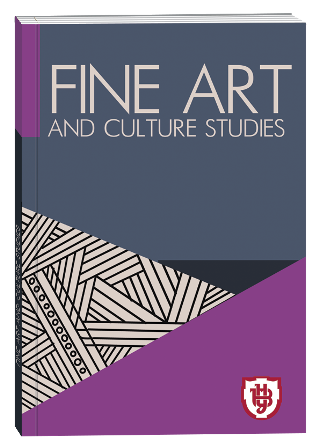THE SYMBOLIC LANGUAGE OF ARCHETYPAL HARMONY COLOURS IN THE PAINTING OF KYIV ARTISTS OF THE LATE XX – EARLY XXI CENTURY
DOI:
https://doi.org/10.32782/facs-2023-1-22Keywords:
colour, symbol, art, language of colour, sacred, symbolic, symbolic language.Abstract
The article focuses on the symbolic language of basic colours – white, black and gray; preconditions for the formation of the hierarchical structure of the colours of archetypal harmony, their impact on the modern language of painting. The definition of the symbolic language of colour is due to the understanding of its role in art and culture, the manifestation of its genesis through – spiritual or everyday. Based on the important role of sacred content in determining the hierarchy of colours, the symbolic meaning of white, black, and gray is clarified on the example of the works of Kyiv artists – I. Pylypenko, A. Kryvolap, V. Gurin, and others. In the balance of these colours, gray symbolizes the beginning and the end, inspiring artists to philosophical search. The development of individual creativity is often shaped by artistic trends, which in turn reveal the role of colour in relation to culture, and because of assimilation of works to the cultural trend from which the artist draws inspiration. Contemporary art is an environment of mixing modern and archaic cultures, for which the scale of sacred colours is more subject to the individual preferences of the author or audience than traditional principles. The connection with ancestors for the Ukrainian people is not an abstract concept, its power is passed down through generations, and despite the prevalence of the world spiritual, the former retains a sacred tone, which in turn is reflected in colour. The symbol plays a joining link between people and art, faith and religion, nature, and science, finding ways to connect each of these bases in the harmonious unity of culture. The issue of colour semantics in the modern context, namely communication with the audience, is becoming one of the main, which requires constant research in the field of public relations, the art of which is becoming increasingly relevant.
References
Прищенко С. В. Кольорознавство : навчальний посібник / за ред. проф. Є. А. Антоновича. Київ : ДАКККіМ, 2009. 358 с.
Прищенко С. В., Прищенко М. О. Семантика кольору у рекламному дизайні: культурологічні та комунікативні аспекти. Парадигма пізнання: Гуманітарні питання ; Інститут реклами. Київ, 2015. № 4(7). URL: https://oaji.net/articles/2015/1739-1440055447.pdf (дата звернення: 15.10. 2021).
Дизайнерська діяльність : системи візуальної інформації. Науково-методичне видання / О. В. Чемакіна та ін. Київ : УкрНД, 2017. 191 с.
Еко У. Відсутня структура. Введення у семіологію / перев. з італ. В. Г. Резнік, А. Г. Погоняйло, 2006. 544 с.
Кабо В. Р. Синкретизм первісного мистецтва. Ранні форми мистецтва, 1972. С. 275–301.
Кандинський В. В. Про духовне у мистецтві (живопис), 1989. 68 с.
Костіна А. Естетика реклами : навчальний посібник, 2003. 296 с.
Неаполітанська С. М., Матвєєв С. А. Сакральна геометрія, 2004. 632 с.
Сєров Н. В. Естетика кольору. Методологічні аспекти хроматизму : монографія. Електронно-бібліотечна система IPRbooks, 2013. 59 с.
Сєров Н. В. Колір культури: психологія, культурологія, фізіологія, 2003. 672 с.







